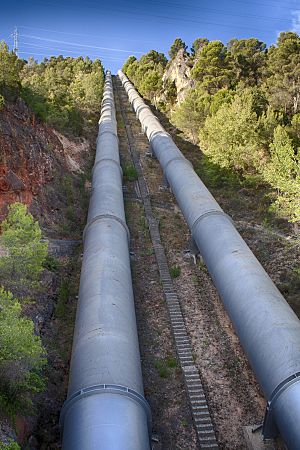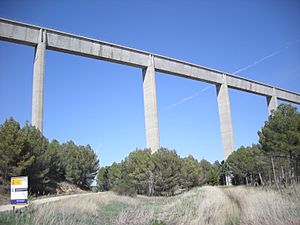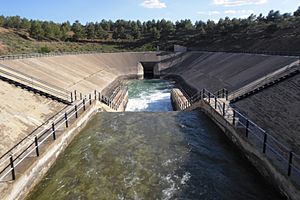Tagus-Segura Water Transfer facts for kids
Quick facts for kids
Tagus-Segura Water Transfer
|
|
|---|---|

The transfer system's course.
|
|
| Begins | Province of Guadalajara, Spain |
| Ends | Province of Albacete |
| Official name | Trasvase Tajo-Segura |
| Maintained by | Government of Spain |
| Characteristics | |
| Total length | 286 km (178 mi) |
| History | |
| Construction start | 1969 |
| Opened | 1979 |
The Tagus-Segura Water Transfer (in Spanish: Trasvase Tajo-Segura) is one of the biggest hydraulic engineering projects ever built in Spain. It's like a giant water pipeline system. This system moves water from the Tagus River in central Spain to the Segura River basin in the southeast. The water comes from large reservoirs like Entrepeñas and Buendía, and it travels all the way to the Talave Reservoir. This helps bring water to areas that need it for drinking and farming.
Contents
How did the Tagus-Segura Transfer Start?
The idea for this water transfer is very old! People first talked about it in 1902. Later, in 1932, a government minister named Indalecio Prieto asked an engineer, Manuel Lorenzo Pardo, to create a plan for managing Spain's water resources.
A year later, the "National Plan of Hydraulic Works" was presented. This plan included the Tagus-Segura Water Transfer. However, for different reasons, the plan wasn't built at that time.
The project was started again in 1966. The goal was to manage water resources in central and southeastern Spain together. The construction of the Tagus-Segura Water Transfer was a big part of this new plan. Finally, in 1979, water from the Tagus River reached the Segura Basin for the first time.
What is the Course of the Water Transfer?
The Tagus-Segura Water Transfer connects the Bolarque Reservoir on the Tagus River to the Talave Reservoir on the Segura River. It is about 292 kilometers (181 miles) long. The system has four main parts:
Section 1: Pumping Water Up High
This first part is very important for moving water uphill. Water from the Bolarque Reservoir, which is at 636 meters (2,087 feet) high, is pumped up to the Bujeda Reservoir. This means the water goes up about 245 m (804 ft)! This is done by a special power plant called Bolarque II. It uses powerful pumps to lift the water.
Section 2: Connecting Reservoirs
This part links the Bujeda Reservoir to the Alarcón Reservoir on the Júcar River. The Alarcón Reservoir acts like a resting place for the water. It helps control the flow and makes sure the system works smoothly.
Section 3: From Alarcón to Talave Tunnel
This section connects the Alarcón Reservoir to the start of the Talave Tunnel.
Section 4: The Long Tunnel and Canal
The biggest part of this section is the Talave Tunnel, which is 32 km (20 mi) long. This tunnel runs deep underground, between 150 m (490 ft) and 320 m (1,050 ft) below the surface. After the tunnel, the water flows into the Talave Canal, which finally leads to the Talave Reservoir on the Mundo River. The Mundo River is a smaller river that flows into the Segura River.
How is the Water Transfer Regulated?
There are rules about how much water can be moved through the Tagus-Segura Water Transfer. These rules were updated in 2013 to make sure the water is managed fairly and clearly. The rules consider how much water is available in the Tagus River's reservoirs (Entrepeñas and Buendía) at the start of each month.
There are four "levels" that decide how much water can be transferred:
- Level 1: Plenty of Water!
* If there's a lot of water in the Entrepeñas and Buendía reservoirs (more than 1,300,000,000 m3 (1,100,000 acre⋅ft)), or if a lot of water has flowed into them in the past year, then a large amount of water can be transferred. This is usually 60,000,000 m3 (49,000 acre⋅ft) per month, but there's a yearly limit.
- Level 2: Enough Water.
* If there's less water than in Level 1, but still a good amount, then a smaller transfer is allowed. This is usually 38,000,000 m3 (31,000 acre⋅ft) per month, also with a yearly limit.
- Level 3: Low Water.
* If the water levels in the reservoirs are quite low, as shown in a special table for each month, then it's considered an "irregular" situation. In this case, only a small amount, up to 20,000,000 m3 (16,000 acre⋅ft), can be transferred, and it needs special approval.
- Level 4: Very Low Water!
* If the water in the Entrepeñas and Buendía reservoirs drops below 400,000,000 m3 (320,000 acre⋅ft), no water can be transferred at all.
The water that is transferred is usually split for different uses: about 25% goes for drinking water in cities, and 75% goes for irrigation (watering crops). At least 7,500,000 m3 (6,100 acre⋅ft) per month is always set aside for drinking water.
What Happens After the Water is Transferred?
The Talave Reservoir is where the "post-transfer system" begins. This is a network of structures that help control, move, and finally deliver the water to different areas. Key parts include the Ojós Diversion Dam, which sends water to various canals like the Almería Canal and the Campo de Cartagena Canal.
A large amount of water from the Tagus-Segura Water Transfer, about 400,000,000 m3 (320,000 acre⋅ft), is used for farming. About half of this water helps new farms, and the other half helps existing farms. The Region of Murcia uses a lot of this water for its farms.
From 1979 to 2014, the Segura Basin received an average of 328,000,000 m3 (266,000 acre⋅ft) of water each year. This is about 55% of the maximum allowed. The amount of water used for public drinking has stayed about the same, but the amount used for farming has varied more.
The Tagus-Segura Water Transfer has helped the Spanish southeast become a major producer of fruits and vegetables, especially out-of-season crops. Because of this, the region is often called the "vegetable garden of Europe."
However, this water transfer has also caused a lot of debate. People have argued about it for many reasons, including how it affects different regions and the environment. Even though it was planned during the Second Spanish Republic, built under a dictatorship, and put into use during Spain's move to democracy, the discussions about its use continue today.
See also
 In Spanish: Trasvase Tajo-Segura para niños
In Spanish: Trasvase Tajo-Segura para niños
- Aqueduct (water supply)
- Hydroelectricity
- Water supply and sanitation in Spain
- List of tunnels in Spain





